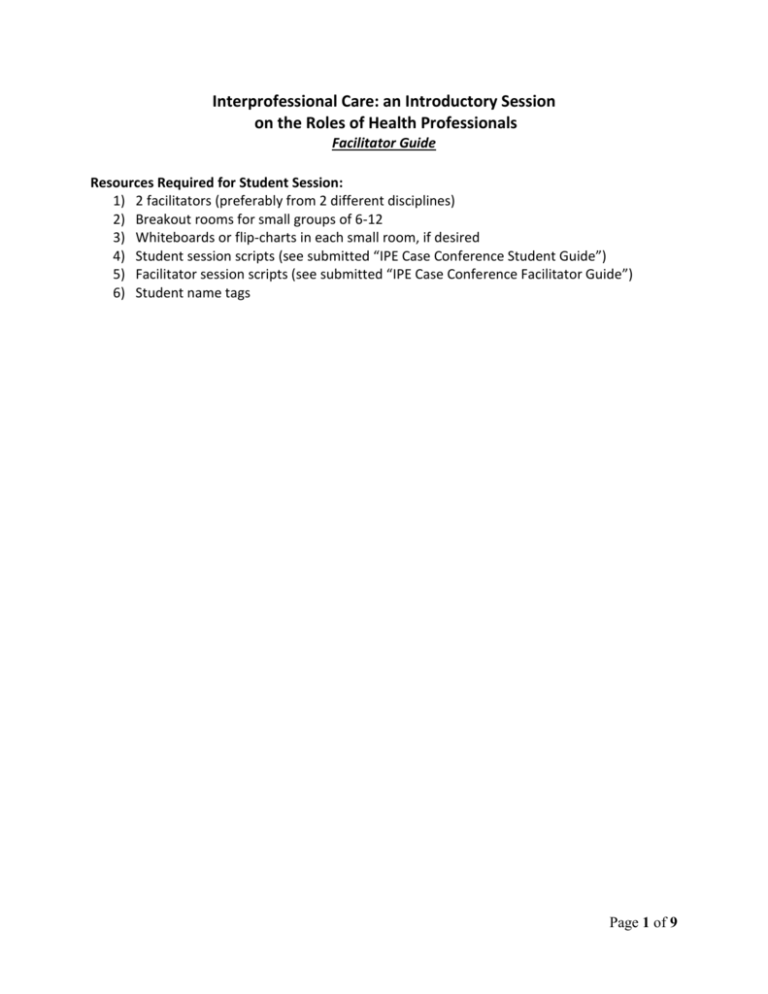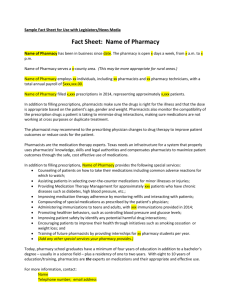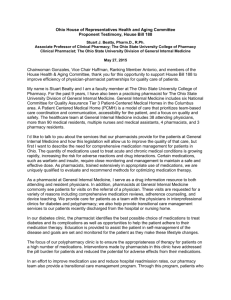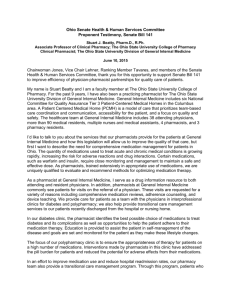IPE Case Conference Facilitator Guide
advertisement

Interprofessional Care: an Introductory Session on the Roles of Health Professionals Facilitator Guide Resources Required for Student Session: 1) 2 facilitators (preferably from 2 different disciplines) 2) Breakout rooms for small groups of 6-12 3) Whiteboards or flip-charts in each small room, if desired 4) Student session scripts (see submitted “IPE Case Conference Student Guide”) 5) Facilitator session scripts (see submitted “IPE Case Conference Facilitator Guide”) 6) Student name tags Page 1 of 9 Interprofessional Care: an Introductory Session on the Roles of Health Professionals Facilitator Guide Overview: The purpose of this session is to highlight the major roles that physicians, pharmacists, and physician assistants play on the patient care team and to identify effective communication skills that can be used to collaborate towards optimal patient outcomes. One of the biggest barriers to interprofessional collegiality is the lack of awareness about the strengths of each team member. This lack of understanding can potentially lead to poor communication between team members, poor efficiency within the team, and ultimately patient care will suffer. The session will primarily utilize group discussion punctuated by small group activities to create interprofessional understanding. Classrooms will consist of students from the physician assistant, pharmacy and medicine programs. Facilitators will consist of faculty from pharmacy, physician assistant and medicine. Goals: 1. Clarify the role of the physicians, pharmacists, and physician assistants on the health care team 2. Formulate the communication skills necessary for working together on a patient care team Outcomes: By the end of the session, students will: 1. Identify and resolve misconceptions about other health professions 2. Collaborate to develop a plan for patient care 3. Produce a list of the best practices for working effectively on a health care team Resources & Recommended Reading: 1. Interprofessional Education Collaborative Expert Panel. (2011). Core competencies for interprofessional collaborative practice: Report of an expert panel. Washington, D.C.: Interprofessional Education Collaborative. 2. Singla DL, MacKinnon GE, MacKinnon KJ, Younis W, Field B. Interdisciplinary approach to teaching medication adherence to pharmacy and osteopathic medical students. JAOA. March 2004; 104 (3): 127-132. 3. Weinstein RS, McNeely RA, Holcomb MJ, et al. Technologies for interprofessional education: The interprofessional education-distributed “e-classroom of the future.” Allied Health. 2010; 39 (3 pt 2): 238-245. 4. Evans CH, Cashman SB, Page DA, Garr DR. Model approaches for advancing interprofessional prevention education. American Journal of Preventive Medicine. 2011; 40 (2): 245-260. 5. Thistlethwaite J, Moran M, on behalf of the World Health Organization Study Group on Inter-professional Education and Collaborative Practice. Learning outcomes for interPage 2 of 9 professional education (IPE): Literature review and synthesis. Journal of Interprofessional Care. September 2010; 24(5): 503-513 6. Executive summary: Standards of medical care in diabetes - 2013. Diabetes Care. 2013; 36 (S1): S11-S66. Timeline Overview: Minutes Description 00:00-00:50 Introductions, Overview, and Ice Breaker Activity 00:50-01:40 Team Building & Taking Care of a Patient 01:40-02:00 Summary and Best Practices 02:00 Session Conclusion The times above are approximate. You may adjust this schedule according to the progress in your group. Schedule and Instructions: 00:00-00:50 Introductions, Overview, and Ice Breaker Activity 1. As students enter the classroom, faculty should instruct them to be seated with their assigned small group, and to sit next to a student from a different health profession. This information will be emailed to the students prior to the session, and a list will also be provided to faculty. 2. The session will begin by faculty welcoming the group, introducing themselves (names, specialty and faculty position). Co-facilitators may decide prior to the session how they wish to be addressed by the group (titles vs. first names), and how they would like the introductions and the session to flow. During introductions faculty should underscore the importance of interprofessional collaboration (perhaps with a brief illustration from practice). 3. Learners will then introduce themselves (names, specialty and level of training) within their own small group and participate in the ice-breaker outlined below. Ice-Breaker - True or False? Ask the students to pair up with a student from a different health profession. Each student should come up with 3 things about their profession; 2 things that are true and one that is false. The students of the other health professions will guess the one that is false. Wrap-up To conclude the icebreaker activity, the classroom will reconvene as a large group to share the 2-3 common misperceptions of each profession. Page 3 of 9 00:50-01:40 Team Building & Taking Care of a Patient During this segment, students will have the opportunity to work through a common patient care scenario. Facilitator Instructions: 1. Set up the expectations of the 4 interprofessional teams formed in your room by outlining the student instructions below. 2. Facilitate team discussion for the groups a. Clarify the meaning of ground rules b. Help to resolve team conflict c. Help students clarify roles as needed d. Keep students on task e. Encourage participation from all team members f. Note: This case is intended to be a catalyst to discuss the team process; it is not about diabetes management 3. Take notes about team processes observed 4. Ensure flow of process and large group reporting in the last 15 minutes 5. Provide commentary on team processes (what worked or did not work) during the large group reporting 6. Collate “best practices” list from all 4 teams on a chart or the whiteboard. Faculty should summarize, record, and submit the top 3 best practices to coordinating faculty. Student Instructions 1. Work together to establish team ground rules 2. Elect a scribe to observe, take notes, and report on the team process (team dynamics; challenges encountered; resulting conflicts and resolutions; misconceptions that were addressed and/or resolved; any revelations that occurred). 3. Task 1, the “huddle” (~25 minutes): Read the case and work together to determine each other’s roles in the care of this patient. What information is needed from the patient or elsewhere? Who will obtain it during the patient encounter? Who will conduct the History, Physical Examination, Medication History, Patient Education (including nutrition, medications, preventative care, and other care related to diabetes), ordering Diagnostics/Labs, making referrals, Medication Management, and who will give the final Case Presentation? Page 4 of 9 4. Task 2 (~10 minutes): Review and reflect upon the process and identify 2-3 best practices that your team used to allow for optimal teamwork and identify 1 or 2 processes that hindered teamwork. Patient Case: You have volunteered to participate in an interprofessional student-run clinic for underserved patients in Los Angeles on a Saturday. Mrs. Torres is the first patient. She is a 41-year-old housewife presenting with a diagnosis of type 2 diabetes. Her elevated blood sugar was first detected while being screened at health fair. She was then seen at another clinic and received a prescription for a once daily oral medication for her diabetes, and was told to follow up after testing her own glucose every morning for 2 weeks. She could not afford to return to that clinic and is here for further treatment. Her husband works 12 to 14 hours a day in construction when there is work available, and she has 4 children ages 1 to 8 years. Her weight is 200 lbs, she is 5’5”, her non-fasting glucose level today is elevated at 240 mg/dl and blood pressure is normal at 120/80 mm Hg. She has not purchased the glucose-testing kit needed for selfmonitoring. 01:40-02:00 Summary and Best Practices Upon reconvening as a large group, give each small group scribe 2-3 minutes to share their team’s reflections and their “best practices.” The following are some potential questions to ask the students: 1. 2. 3. 4. 5. 6. 7. What surprised you about the role of another team member? What are the shared goals are for this patient? What was easiest and most difficult about working together? What lessons did you learn about working together as health professionals? Who was missing from the team? What would they have potentially contributed? What information is needed from other professional team member(s)? What barriers did you discover to providing optimal patient care? Concluding the session as a large group, summarize at least 3 “best practice”’ principles for interprofessional communication that can be generalized to other settings. These can be recorded on a whiteboard, powerpoint slide, or flip-chart, if desired. END OF SESSION Page 5 of 9 Session Evaluation Methods Standard course evaluations if already used in the existing course. These may consist of survey questions using Likert scale responses to questions such as: - Were learning objectives clearly stated? - Were learning objectives met? - Was the content relevant to your needs? - How effective were the faculty facilitators? Page 6 of 9 Appendix Professional Roles & Scopes of Practice of Selected Healthcare Providers (Adapt according to your program-specific needs) Physicians Physicians, often referred to as doctors, serve a fundamental role in our society and have an effect upon all our lives. They diagnose illnesses and prescribe and administer treatment for people suffering from injury or disease. Physicians examine patients; obtain medical histories; and order, perform, and interpret diagnostic tests. They counsel patients on diet, hygiene, and preventive health care. About one third of the nation’s physicians are generalists—“primary care” doctors who provide lifelong medical services. These include internists, family physicians, and pediatricians. Generalists provide a wide range of services children and adults need. When patients’ specific health needs require further treatment, generalist physicians send them to see a specialist physician. Specialist physicians, such as neurologists, cardiologists, and ophthalmologists, differ from generalists in that they focus on treating a particular system or part of the body. They collaborate with generalist physicians to ensure that patients receive treatment for specific medical problems as well as complete and comprehensive care throughout life. Source: AMA’s Physician Characteristics and Distribution in the US, 2008 edition Physician Assistants What is a physician assistant? A physician assistant (PA) is a medical professional who works as part of a team with a physician. A PA is a graduate of an accredited PA educational program who is nationally certified and state-licensed to practice medicine with the supervision of a physician. What can PAs do? PAs perform physical examinations, diagnose and treat illnesses, order and interpret lab tests, perform procedures, assist in surgery, provide patient education and counseling and make rounds in hospitals and nursing homes. All 50 states and the District of Columbia allow PAs to practice and prescribe medications. PAs typically do the following: Work with the supervision of a physician or surgeon Take thorough patient medical histories Perform physical exams Order and interpret diagnostic tests, such as blood tests, x-rays, MRIs, and ultrasounds Diagnose patient illness and evaluate patient injury Provide treatment, such as setting broken bones and giving immunizations Counsel patients and their families about medical conditions Prescribe medication or write drug orders Perform surgical procedures, including suturing and casting Page 7 of 9 How are PAs educated and trained? The PA educational program is modeled on the medical school curriculum, a combination of classroom and clinical instruction. The PA course of study is rigorous and intense. The average length of a PA education program is 27 months. PA education includes instruction in core sciences: anatomy, physiology, biochemistry, pharmacology, physical diagnosis, pathophysiology, microbiology, clinical laboratory science, behavioral science and medical ethics. Rotations may include family medicine, internal medicine, obstetrics and gynecology, pediatrics, general surgery, emergency medicine and psychiatry, totaling over 2,000 hours of clinical rotations. Practicing PAs participate in lifelong learning. In order to maintain national certification, a PA must complete 100 hours of continuing medical education every two years. There are currently 170 accredited PA programs in the United States. The vast majority award master’s degrees. The Keck School of Medicine of USC PA Program is a 33-month Master’s Degree program. How do physicians and PAs work together? By design, physicians and PAs work together as a team, and all PAs practice medicine with physician supervision. Supervision does not mean, though, that a supervising physician must always be present with the PA or direct every aspect of PA-provided care. PAs are trained and educated similarly to physicians, and therefore share similar diagnostic and therapeutic reasoning. Physician-PA practice can be described as delegated autonomy. Physicians delegate duties to PAs, and within those range of duties, PAs use autonomous decision-making for patient care. This team model is an efficient way to provide high-quality medical care. In rural areas, the PA may be the only healthcare provider on-site, collaborating with a physician elsewhere through telecommunication. Adapted from: 1) The American Academy of Physician Assistants website, http://www.aapa.org/the_pa_profession/what_is_a_pa.aspx 2) The United States Bureau of Labor Statistics Occupational Outlook Handbook, http://www.bls.gov/ooh/healthcare/physician-assistants.htm Pharmacists What is a pharmacist? A pharmacist is a health care professional who works to ensure the safe and effective use of medications. Pharmacy is practiced in a wide range of settings: community pharmacies, hospitals, long term care facilities, the pharmaceutical industry, mail service, managed care, and government. What can pharmacists do? Pharmacists perform many tasks related to healthcare in addition to the traditional role of drug preparation and distribution. After an initial diagnosis is made, pharmacists deliver many patient care services and function as health care providers in a variety of practice settings to manage disease in patients (where medications are the primary mode of treatment). Pharmacists’ current scope of practice positions them to provide these services through Collaborative Practice Agreements (CPAs) with physicians or within any coordinated patient care models such as the Patient Centered Medical Home (PCMH). Pharmacists can: Prepare, compound, and dispense medications Perform patient assessment (subjective and objective data including physical assessment) Page 8 of 9 Have prescriptive authority (initiate, adjust, or discontinue treatment) to manage disease through medication use and deliver collaborative drug therapy or medication management Order, interpret and monitor laboratory tests Formulate clinical assessments and develop therapeutic plans Provide care coordination and other health services for wellness and prevention of disease Develop partnerships with patients for ongoing (follow-up) care Educate patients, health professionals, and the public regarding the safe and effective use of medications How are pharmacists educated and trained? Historically, educational requirements for pharmacists included the choice of two entry-level degrees: a five-year Bachelor of Science in pharmacy (BS Pharmacy) or a six-year Doctor of Pharmacy (PharmD). However, as of the year 2000, most schools of pharmacy began offering only the PharmD degree. To gain admission one must have at least two years of college study with courses including math, chemistry, biology, physics, humanities and social sciences. Many programs require a bachelor’s degree prior to admission, and applicants generally have to take the Pharmacy College Admissions Test (PCAT). Pharm.D. programs are usually 4 years in length, although some programs offer a 3-year option. Coursework includes anatomy, physiology, pharmaceutics, pharmacology, therapeutics, public health, law and ethics, pharmacy practice, pharmacy administration, as well as experiential education in a variety of healthcare settings. Pharmacists seeking an advanced pharmacy position, such as in clinical pharmacy or pharmaceutical industry, may choose to complete a 1- to 2-year residency or fellowship following their Pharm. D. After completion of the Pharm. D., prospective pharmacists must pass two exams to become licensed to practice. The North American Pharmacist Licensure Exam (NAPLEX) is an exam on skills and knowledge. Most states require graduates to pass an exam on pharmacy law such as the Multistate Pharmacy Jurisprudence Exam (MPJE), or the California Pharmacy Jurisprudence Exam (CPJE). In pharmacy – as in all healthcare practices – specialization has become essential to optimizing patient care. Pharmacists, upon passing an exam, may become board certified by the Board of Pharmaceutical Specialties (BPS) in Ambulatory Care, Critical Care, Nuclear Pharmacy, Nutrition Support, Oncology, Pediatrics, Pharmacotherapy, or Psychiatric Pharmacy. Adapted from: 1) The American Pharmacists Association (APhA) website, http://www.pharmacist.com 2) The United States Bureau of Labor Statistics Occupational Outlook Handbook, http://www.bls.gov/ooh/Healthcare/Pharmacists.htm#tab-4 3) Scope of contemporary pharmacy practice: roles, responsibilities, and functions of pharmacists and pharmacy technicians. .J Am Pharm Assoc 2010 Mar-Apr 1;50(2):e35-69 Page 9 of 9





